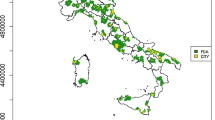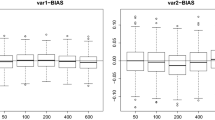Abstract
One of the main research trends in contemporary survey sampling and the need to improve the accuracy of the Lithuanian Labor force survey estimates in small geographic areas have stimulated this study. The aim of the paper is to compare area level models and estimation methods for the fraction of the unemployed using simulation based on the Lithuanian Labor Force Survey data. The Fay–Herriot area level model, estimated by empirical best linear unbiased prediction, and the unmatched logit-normal-normal and binomial-logit-normal models, estimated using hierarchical Bayes analysis, are applied. Bayesian imputation is used for areas without sample data. We suggest the composition of some model elements.
Similar content being viewed by others
References
H.J. Boonstra, B. Buelens, K. Leufkens, and M. Smeets, Small area estimates of labour status in Dutchmunicipalities, Discussion paper No. 201102, Statistics Netherlands, The Hague, 2011.
H.J. Boonstra, B. Buelens, and M. Smeets, Estimation of municipal unemployment fractions – a simulation study comparing different small area estimators, Project No. DMH-205714, Statistics Netherlands, The Hague, 2009.
G. Datta and M. Ghosh, Small area shrinkage estimation, Stat. Sci., 27(1):95–114, 2012.
G.S. Datta, Model-based approach to small area estimation, in D. Pfeffermann and C.R. Rao (Eds.), Handbook of Statistics. Sample Surveys: Inference and Analysis, Vol. 29B, Elsevier, North Holland, 2009, pp. 251–288.
G.S. Datta, P. Lahiri, T. Maiti, and K.L. Lu, Hierarchical Bayes estimation of unemployment rates for the states of the U.S., J. Am. Stat. Assoc., 94(448):1074–1082, 1999.
E. Fabrizi, Hierarchical Bayesian models for the estimation of unemployment rates in small domains of the Italian Labour Force Survey, Statistica, LXII(4):603–618, 2002.
P.J. Farrell, Bayesian inference for small area proportions, Sankhyā, Ser. B, 62(3):402–416, 2000.
R.E. Fay and R.A. Herriot, Estimates of income for small places: An application of James–Stein procedures to census data, J. Am. Stat. Assoc., 74(366):269–277, 1979.
J. Geweke, Contemporary Bayesian Econometrics and Statistics, Wiley Series in Probability and Statistics, John Wiley & Sons, Hoboken, NJ, 2005.
M. Ghosh and G. Meeden, Bayesian Methods for Finite Population Sampling, Chapman & Hall, London, 1997.
M. Ghosh and J.N.K. Rao, Small area estimation: An appraisal, Stat. Sci., 9(1):55–93, 1994.
T. Klimanek, Using indirect estimation with spatial autocorellation in social surveys in Poland, Przegl. Stat., 1(spec. issue):155–172, 2012.
D. Krapavickaitė, An example of small area estimation in finite population sampling, Liet. Mat. Rink., 43(spec. issue):497–503, 2003.
J. Kubacki, Application of the hierarchical Bayes estimation to the Polish Labour Force Survey, Statistics in Transition, 6(5):785–796, 2004.
R. Lehtonen and A. Veijanen, Design-based methods of estimation for domains and small areas, in D. Pfeffermann and C.R. Rao (Eds.), Handbook of Statistics. Sample Surveys: Inference and Analysis, Volume 29B, Elsevier, North Holland, 2009, pp. 219–249.
D. Malec, J. Sedransk, C.L. Moriarity, and F.B. LeClere, Small area inference for binary variables in the national health interview survey, J. Am. Stat. Assoc., 92(439):815–826, 1997.
J.N.K. Rao, Small Area Estimation, JohnWiley & Sons, Hoboken, NJ, 2003.
C. Ritter and M. A. Tanner, Facilitating the Gibbs sampler: The Gibbs stopper and the griddy-Gibbs sampler, J. Am. Stat. Assoc., 87(419):861–868, 1992.
C.P. Robert, The Bayesian Choice, Springer, New York, 2007.
M.P. Singh, J. Gambino, and H. Mantel, Issues and strategies for small area data, Survey Methodology, 20(1):3–22, 1994.
Statisticat, LLC, Laplacesdemon: Complete environment for Bayesian inference, R package version 14.04.05, 2014, available from: http://www.bayesian-inference.com/software.
N. Torelli and M. Trevisani, Labour force estimates for small geografical domains in Italy: Problems, data and models, Working paper No. 118, University of Trieste, 2008.
M. Trevisani and N. Torelli, Hierarchical Bayesian models for small area estimation with count data, Working paper No. 115, University of Trieste, 2007.
Y. You and B. Chapman, Small area estimation using area level models and estimated sampling variances, Survey Methodology, 32(1):97–103, 2006.
Y. You, J.N.K. Rao, and J. Gambino, Model-based unemployment rate estimation for the Canadian Labour Force Survey: A hierarchical Bayes approach, Survey Methodology, 29(1):25–32, 2003.
Author information
Authors and Affiliations
Corresponding author
Rights and permissions
About this article
Cite this article
Krapavickaitė, D., Rudys, T. Small Area Estimates for the Fraction of the Unemployed. Lith Math J 55, 243–254 (2015). https://doi.org/10.1007/s10986-015-9277-9
Received:
Revised:
Published:
Issue Date:
DOI: https://doi.org/10.1007/s10986-015-9277-9




